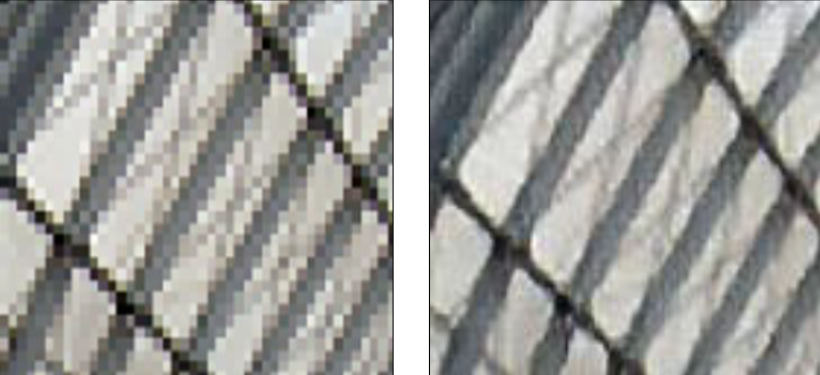[Super Resolution] 3-2. SRGAN 코드 리뷰
in Paper-Review
Photo-Realistic Single Image Super-Resolution Using a Generative Adversarial Network
모델 구조

그림과 같이 새로운 데이터(SR)을 생성하는 Generator model과 그 데이터를 판단하는 Discriminator model로 이루어졌다. Super-Resolution에서 GAN의 구조를 처음으로 도입하였다.
Usage
usage: main.py [-h] [--batchSize BATCHSIZE] [--nEpochs NEPOCHS] [--cuda]
[--threads THREADS] [--pretrained PRETRAINED] [--gpus GPUS]
PyTorch SRGAN
optional arguments:
-h, --help show this help message and exit
--batchSize BATCHSIZE
--nEpochs NEPOCHS
--cuda
--threads THREADS
--pretrained PRETRAINED
--gpus GPUS
Data augmentation
flip
for flip in [0,1]:
if flip == 0:
image_f = image
else:
image_f = cv2.flip(image,1)
rotate
def img_rotate(img, degree):
height, width = img.shape
matrix = cv2.getRotationMatrix2D((width/2, height/2), 90*degree, 1)
if degree == 1 or degree == 3:
dst = cv2.warpAffine(img, matrix, (height, width))
else:
dst = cv2.warpAffine(img, matrix, (width, height))
return dst
downsize
def img_downsize(img, ds):
dst = cv2.resize(img, dsize=(0, 0), fx=ds, fy=ds, interpolation=cv2.INTER_LINEAR)
return dst
crop image
def sub_img(input, label, i_size = 33, l_size = 21, stride = 14):
sub_ipt = []
sub_lab = []
pad = abs(i_size-l_size)//2
for h in range(0, input.shape[0] - i_size + 1, stride):
for w in range(0, input.shape[1] - i_size + 1, stride):
sub_i = input[h:h+i_size,w:w+i_size]
sub_l = label[h + pad :h + pad + l_size,w + pad :w + pad + l_size]
sub_i = sub_i.reshape(1, i_size,i_size)
sub_l = sub_l.reshape(1, l_size,l_size)
sub_ipt.append(sub_i)
sub_lab.append(sub_l)
return sub_ipt, sub_lab
down scale
def zoom_img(img, scale):
label = img.astype('float') / 255
temp_input = cv2.resize(label, dsize=(0, 0), fx=1/scale, fy=1/scale, interpolation=cv2.INTER_AREA)
input = cv2.resize(temp_input, dsize=(0, 0), fx=scale, fy=scale, interpolation=cv2.INTER_CUBIC)
return input, label
Model
- Generator Model
class G_Net(nn.Module):
def __init__(self):
super(G_Net, self).__init__()
self.input = nn.Sequential(
nn.Conv2d(3, 64, kernel_size=9, padding=4),
nn.PReLU()
)
self.ResidualBlock1 = ResidualBlock(64)
self.ResidualBlock2 = ResidualBlock(64)
self.ResidualBlock3 = ResidualBlock(64)
self.ResidualBlock4 = ResidualBlock(64)
self.ResidualBlock5 = ResidualBlock(64)
self.output_residual = nn.Sequential(
nn.Conv2d(64, 64, kernel_size=3, padding=1),
nn.BatchNorm2d(64)
)
self.pixel_shuffle = nn.Sequential(
nn.Conv2d(64, 64 * 2 ** 2, kernel_size=3, padding=1),
nn.PixelShuffle(2),
nn.PReLU()
)
self.pixel_shuffle2 = nn.Sequential(
nn.Conv2d(64, 64 * 2 ** 2, kernel_size=3, padding=1),
nn.PixelShuffle(2),
nn.PReLU()
)
self.output = nn.Sequential(
nn.Conv2d(64, 3, kernel_size=9, padding=4),
nn.Tanh()
)
def forward(self, x):
input = self.input(x)
ResidualBlock1 = self.ResidualBlock1(input)
ResidualBlock2 = self.ResidualBlock2(ResidualBlock1)
ResidualBlock3 = self.ResidualBlock3(ResidualBlock2)
ResidualBlock4 = self.ResidualBlock4(ResidualBlock3)
ResidualBlock5 = self.ResidualBlock5(ResidualBlock4)
output_residual = self.output_residual(ResidualBlock5)
pixel_shuffle = self.pixel_shuffle(output_residual + input)
pixel_shuffle2 = self.pixel_shuffle2(pixel_shuffle)
output = self.output(pixel_shuffle2)
output = (output+1)/2
return output
- Discriminator Model
class D_Net(nn.Module):
def __init__(self):
super(D_Net, self).__init__()
self.Net = nn.Sequential(
nn.Conv2d(3, 64, kernel_size=3, padding=1),
nn.LeakyReLU(0.2),
nn.Conv2d(64, 64, kernel_size=3, stride=2, padding=1),
nn.BatchNorm2d(64),
nn.LeakyReLU(0.2),
nn.Conv2d(64, 128, kernel_size=3, padding=1),
nn.BatchNorm2d(128),
nn.LeakyReLU(0.2),
nn.Conv2d(128, 128, kernel_size=3, stride=2, padding=1),
nn.BatchNorm2d(128),
nn.LeakyReLU(0.2),
nn.Conv2d(128, 256, kernel_size=3, padding=1),
nn.BatchNorm2d(256),
nn.LeakyReLU(0.2),
nn.Conv2d(256, 256, kernel_size=3, stride=2, padding=1),
nn.BatchNorm2d(256),
nn.LeakyReLU(0.2),
nn.Conv2d(256, 512, kernel_size=3, padding=1),
nn.BatchNorm2d(512),
nn.LeakyReLU(0.2),
nn.Conv2d(512, 512, kernel_size=3, stride=2, padding=1),
nn.BatchNorm2d(512),
nn.LeakyReLU(0.2),
nn.AdaptiveAvgPool2d(1),
nn.Conv2d(512, 1024, kernel_size=1),
nn.LeakyReLU(0.2),
nn.Conv2d(1024, 1, kernel_size=1),
nn.Sigmoid()
)
def forward(self, x):
x = self.Net(x)
return x.squeeze()
Train
for epoch_ in range(epoch, opt.nEpochs + 1):
print("===> Start epoch {} #################################################################".format(epoch_))
G_Net.train()
D_Net.train()
for _, (input, label) in enumerate(training_data_loader):
HR = Variable(label)/255
LR = Variable(input)/255
if torch.cuda.is_available():
HR = HR.cuda()
LR = LR.cuda()
fake_img = G_Net(LR)
# Train Discriminator model
D_Net.zero_grad()
real_rate = D_Net(HR)
fake_rate = D_Net(fake_img)
d_loss = D_Loss(fake_rate, real_rate)
d_loss.backward()
D_optim.step()
# Train Generator model
G_Net.zero_grad()
g_loss = G_Loss(fake_rate, fake_img, HR)
g_loss.backward()
G_optim.step()
loss function
- GeneratorLoss(MSE_loss + VGG_loss + Adversarial_loss)
class GeneratorLoss(nn.Module):
def __init__(self):
super(GeneratorLoss, self).__init__()
vgg = vgg16(pretrained=True)
vgg_loss = nn.Sequential(*list(vgg.features)[:31]).eval()
for param in vgg_loss.parameters():
param.requires_grad = False
self.vgg_loss = vgg_loss
self.mse_loss = nn.MSELoss()
self.cross_entropy = nn.BCELoss()
def forward(self, fake_rate, SR, HR):
# MSE Loss
MSE_loss = self.mse_loss(SR, HR)
# VGG Loss
VGG_loss = self.mse_loss(self.vgg_loss(SR), self.vgg_loss(HR))
# Adversarial Loss
Adversarial_loss = self.cross_entropy(fake_rate,torch.ones(fake_rate.size(0)).cuda())
return MSE_loss + 6e-3 * VGG_loss + 1e-3 * Adversarial_loss
- DiscriminatorLoss(Fake_img Correct Rate + Real_img Correct Rate)
class DiscriminatorLoss(nn.Module):
def __init__(self):
super(DiscriminatorLoss, self).__init__()
self.cross_entropy = nn.BCELoss()
def forward(self, fake_rate, real_rate):
# Fake_img Correct Rate
Fake_img_CR = self.cross_entropy(fake_rate,torch.zeros(fake_rate.size(0)).cuda())
# Real_img Correct Rate
Real_img_CR = self.cross_entropy(real_rate,torch.ones(real_rate.size(0)).cuda())
return Fake_img_CR + Real_img_CR
Test
Parameters
batchSize =64
cuda = True
lr = 0.001
nEpochs = 20
optimizer= 'Adam'
-> 30 hours for train
Result[LR(left), SR(right)]

원본사진에서 매우 작은 부분을 확대한 이미지인 만큼 엄청나게 선명한 이미지는 아니지원 원본(왼쪽)에 비해 결과물(오른쪽)이 경계선부분이 훨씬 매끄러운것을 알 수 있다.